

'A God That Could Be Real' In The Scientific Universe : 13.7: Cosmos And Culture. The star in the center, as seen by the Hubble Space Telescope, is known as V1331 Cyg and is located in the dark cloud LDN 981.
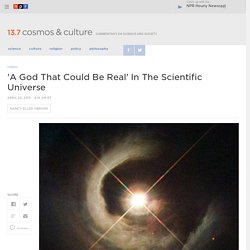
Karl Stapelfe/ESA/Hubble, NASA hide caption itoggle caption Karl Stapelfe/ESA/Hubble, NASA The star in the center, as seen by the Hubble Space Telescope, is known as V1331 Cyg and is located in the dark cloud LDN 981. Karl Stapelfe/ESA/Hubble, NASA Part One Of Two. "God" is a word. For more than 30 years, I have had a ringside seat to one of the most exciting scientific revolutions of our time, the revolution in cosmology. My husband, Joel R. Rutherford's Nuclear World: The Story of the Discovery of the Nucleus Ernest Rutherford discovered the nucleus of the atom in 1911.
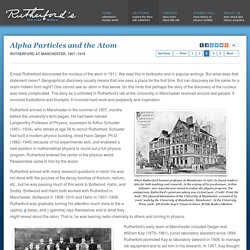
We read this in textbooks and in popular writings. But what does that statement mean? Welcome to Facebook - Log In, Sign Up or Learn More. Why Atheists Need Captain Kirk : 13.7: Cosmos And Culture. Actors in the TV series Star Trek (from left) Leonard Nimoy as Commander Spock, William Shatner as Captain Kirk, DeForest Kelley as Doctor McCoy and James Doohan as Commander Scott.

AP hide caption itoggle caption AP Actors in the TV series Star Trek (from left) Leonard Nimoy as Commander Spock, William Shatner as Captain Kirk, DeForest Kelley as Doctor McCoy and James Doohan as Commander Scott. "European society is very advanced, very civilized. Between holocausts. " The painter Barnett Newman is said to have replied along these lines to a friend who was bemoaning the sorry state of American political life and praising European social democracy. It's a good joke. Scientists, and cultural defenders of science, like to think of themselves as free of prejudice and superstition, as moved by reason alone and a clear-eyed commitment to fact and the scientific method. To which one might reply: Science is all those things. Scientists supported Hitler the same as anyone else. How Our Story About A Child's Science Experiment Sparked Controversy.
Hide captionTwo lionfish swim in an aquarium at the Nova Southeastern University Oceanographic Center in Dania Beach, Fla.
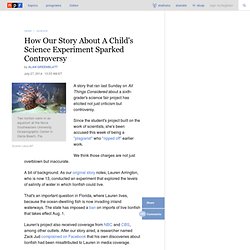
Suzette Laboy/AP Two lionfish swim in an aquarium at the Nova Southeastern University Oceanographic Center in Dania Beach, Fla. A story that ran last Sunday on All Things Considered about a sixth-grader's science fair project has elicited not just criticism but controversy. Since the student's project built on the work of scientists, she's been accused this week of being a "plagiarist" who "ripped off" earlier work. We think those charges are not just overblown but inaccurate. A bit of background. Doing Science In The Wild : 13.7: Cosmos And Culture. John All of Western Kentucky University talks about his accident while recovering in Katmandu, Nepal, on May 22, 2014.
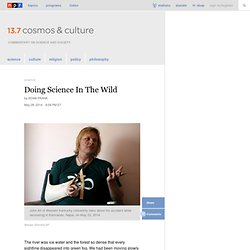
Cosmic Confusion: It's How Science Gets Done : 13.7: Cosmos And Culture. The sun rises behind the cosmic microwave background (CMB) radiation telescopes at the National Science Foundation's South Pole Station.

Steffen Richter/Harvard University hide caption itoggle captionSteffen Richter/Harvard University The sun rises behind the cosmic microwave background (CMB) radiation telescopes at the National Science Foundation's South Pole Station. Don't Pop That Bubble Wrap! Scientists Turn Trash Into Test Tubes : Goats and Soda. Hide captionClear and clean, bubble wrap is well-suited to serve as an array of tiny test tubes.
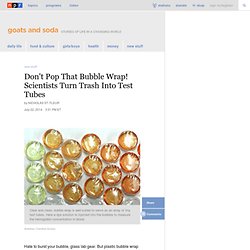
Here a dye solution is injected into the bubbles to measure the hemoglobin concentration in blood. American Chemical Society Clear and clean, bubble wrap is well-suited to serve as an array of tiny test tubes. Here a dye solution is injected into the bubbles to measure the hemoglobin concentration in blood. Hate to burst your bubble, glass lab gear. Scientists at Harvard University have figured out a way to use these petite pouches as an inexpensive alternate to glass test tubes and culture dishes. "Most lab experiments require equipment, like test tubes or 96-well assay plates," says chemist George Whitesides, who led the study.
One glass test tube can cost between $1 and $5. 10 Scientific Ideas That Scientists Wish You Would Stop Misusing. Does Science Have Limits? : 13.7: Cosmos And Culture. Hide captionIn the quest to understand our world and the universe in which it sits, Marcelo Gleiser advises: "Not all questions have answers.
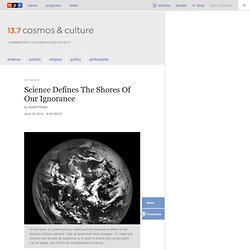
To hope that science will answer all questions is to want to shrink the human spirit, clip its wings, rob it from its multifaceted existence. " Goddard/Arizona State University/NASA In the quest to understand our world and the universe in which it sits, Marcelo Gleiser advises: "Not all questions have answers. To hope that science will answer all questions is to want to shrink the human spirit, clip its wings, rob it from its multifaceted existence. " The very first time I met Marcelo Gleiser he wanted us to start some trouble.
The usual triumphalist narrative of science as the one-and-only path to truth — a complete and all-encompassing truth — was, for us, dangerously limited. Stephanie Kwolek, Chemist Who Created Kevlar, Dies At 90. Chemical Heritage Foundation/YouTube Women in Chemistry: Stephanie Kwolek Stephanie Kwolek, a DuPont chemist who invented the synthetic fibers used in Kevlar body armor, has died at the age of 90, her colleagues said Friday.
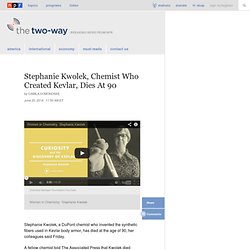
A fellow chemist told The Associated Press that Kwolek died Wednesday at a Wilmington, Del., hospital following a brief illness. Kwolek was a groundbreaking scientist and mentor to other women in the field. Sixth-Grader's Science Fair Finding Shocks Ecologists. Hide captionLauren Arrington's sixth-grade research project is cited in a science journal.

Courtesy of Lauren Arrington Lauren Arrington's sixth-grade research project is cited in a science journal. When 12-year-old Lauren Arrington heard about her sixth-grade science project, she knew she wanted to study lionfish.